Ever wish your car could look showroom new without the high cost or hassle of a professional wash? You can! A do it yourself car wash gives you full control over your car care. It lets you save money and professional, shiny results at home, just by using the right tools. This guide will show you simple steps, eco-friendly hacks, and expert level tricks for a perfect shine.
Start your journey to a spotless clean car, the DIY way!
DIY Car Wash Basics
Want that showroom-shine at home? Washing it yourself is easier than you think, and it works great if you know a few simple tricks. Many people worry how to wash a car without leaving scratches and water spots. The good news is, there are easy ways to avoid both!
One of the best ways to prevent scratches is the two-bucket method. And always wash your car in the shade. This is not just to keep you cool, it stops the sun from drying the water too fast, which causes annoying water spots.
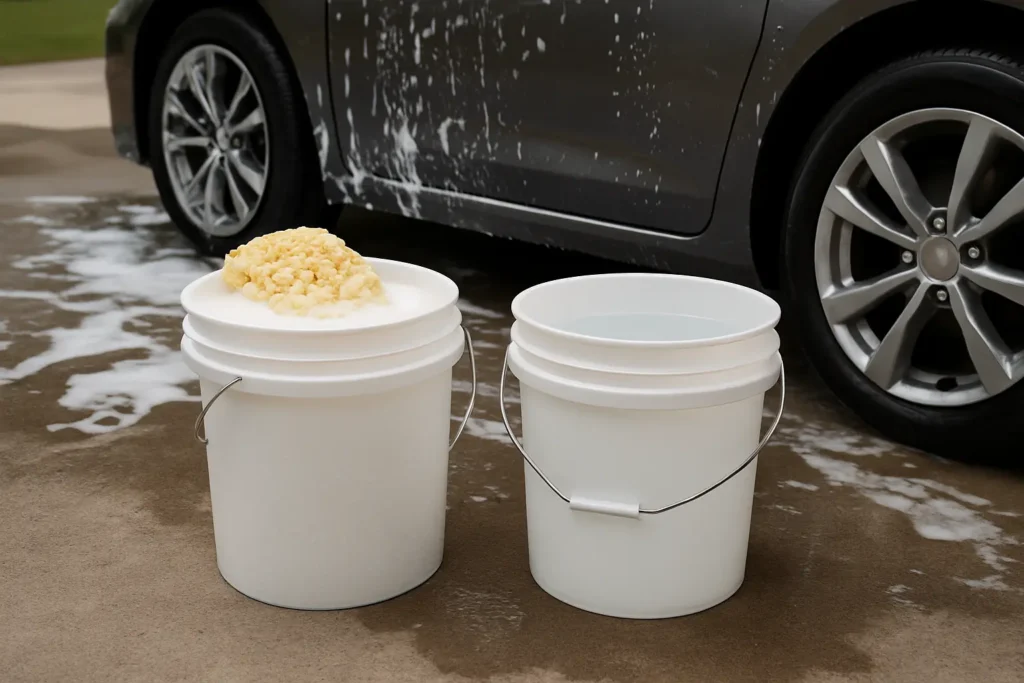
Here is a simple, step-by-step guide to washing your car at home:
- Get Ready: Always park your car where it is shady. Direct sunlight makes water and soap dry too quickly, leaving spots.
- First Rinse: Spray your car all over with a hose. This gets rid of loose dirt and dust, making the main wash safer and more effective.
- Two Buckets, One Goal: Fill one bucket with car wash soap and water (make it foamy!). The second bucket is just for clean water to rinse your wash mitt.
- Wash in Sections: Dip your wash mitt in the soapy water. Wash a small part of your car, starting from the top and working down. After each section, rinse your mitt well in the clean water before getting more soap. This keeps your wash water clean and stops dirt from spreading.
- Final Rinse: Once you have washed the whole car, rinse off all the soap and dirt with your hose. Make sure no soap is left behind, as it can also cause spots.
- Dry It Right: This is super important for a spotless finish! Use a clean, soft microfiber cloth to gently pat your car dry. Do not rub, as this can leave swirly marks. Microfiber towels soak up water well and are gentle on your car paint.
Follow these easy steps to achieve a professional level clean without the risk of damaging your car.
Pick the Best Soap for Your Car
Choosing the right soap for your car is a big deal. It protects your paint and gets your car really clean. You might think, “Cannot I just use dish soap?” While dish soap is great for greasy dishes, it is not good for your car. It can strip off the wax that protects your paint and does not have the lubricants that stop scratches.
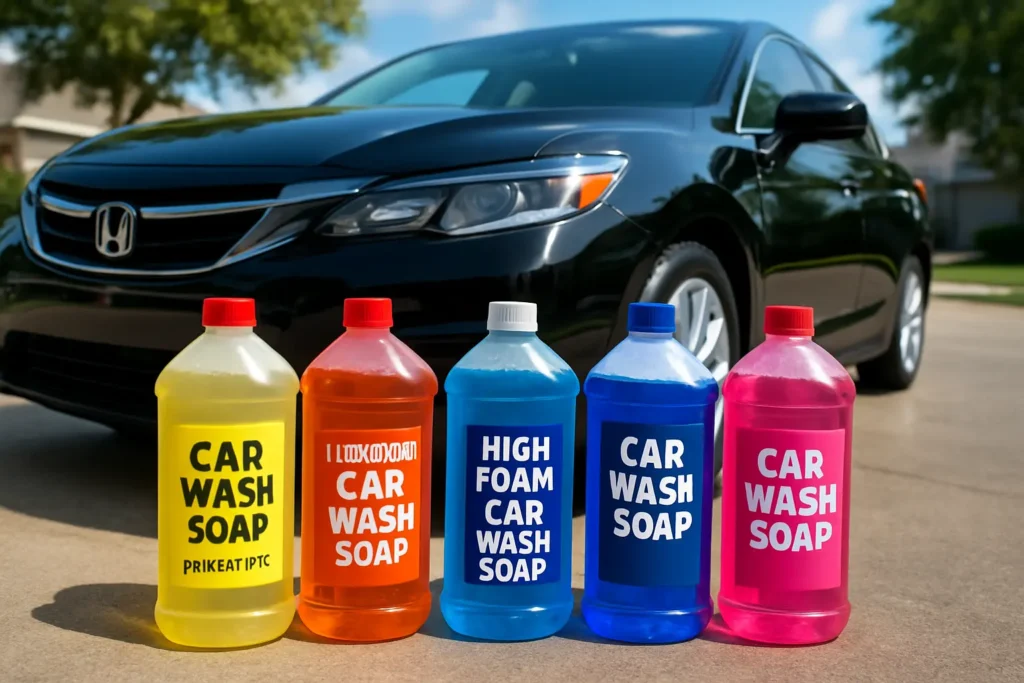
Car wash soaps made for cars are different. They clean well but are gentle on your car paint. They might cost a little more, but they are worth it for regular, safe cleaning. These special soaps have lubricants and are pH-balanced to keep your car wax and clear coat safe.
Here is what to look for when buying car wash soap:
- pH Neutral: This just means the soap would not hurt your car wax or paint. Select one with this label.
- Lubrication: Soaps with good lubrication make your wash mitt glide over the paint. This means less rubbing and fewer chances of scratches.
- Foam Production: A thick, foamy soap is not just fun; it helps lift dirt away from the paint, making it even safer to wash.
- Additives: Some soaps have wax or ceramic stuff already mixed in. These can give your car extra shine and protection.
Choosing the right car wash soap is a small step, but it makes a huge difference in how your car looks and how long its paint stays nice.
Say Goodbye to Water Spots
Ever wash your car only to find annoying water spots when it dries? These spots happen when minerals in the water dry on your car, especially if you wash in direct sunlight, let your car air dry, or use hard water. Want to avoid them? It is all about doing things the right way at the right time.
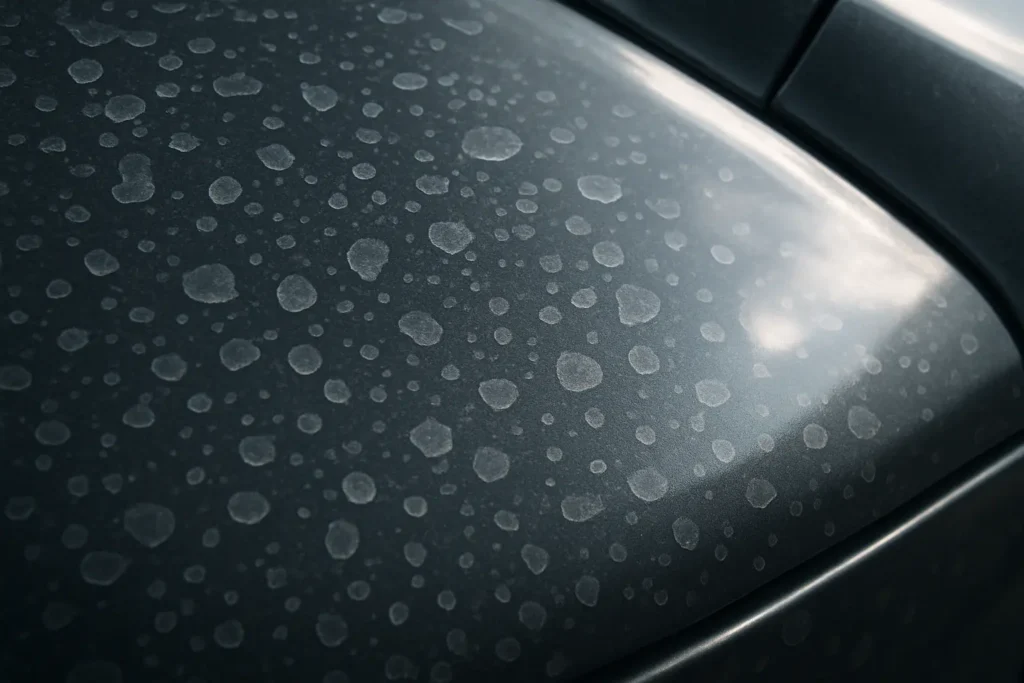
Thinking about how to avoid water spots on cars? The best way to avoid spots is through proper technique and timing.
- Wash your car under shade or during cooler hours of the day. This gives you more time before the water dries.
- When rinsing thoroughly, use strong water pressure to get all the soap and dirt off, but do not leave water for sitting on the car.
- Dry the surface immediately with a clean microfiber cloth. This stops those minerals from drying and leaving spots, giving you that perfect, spotless shine.
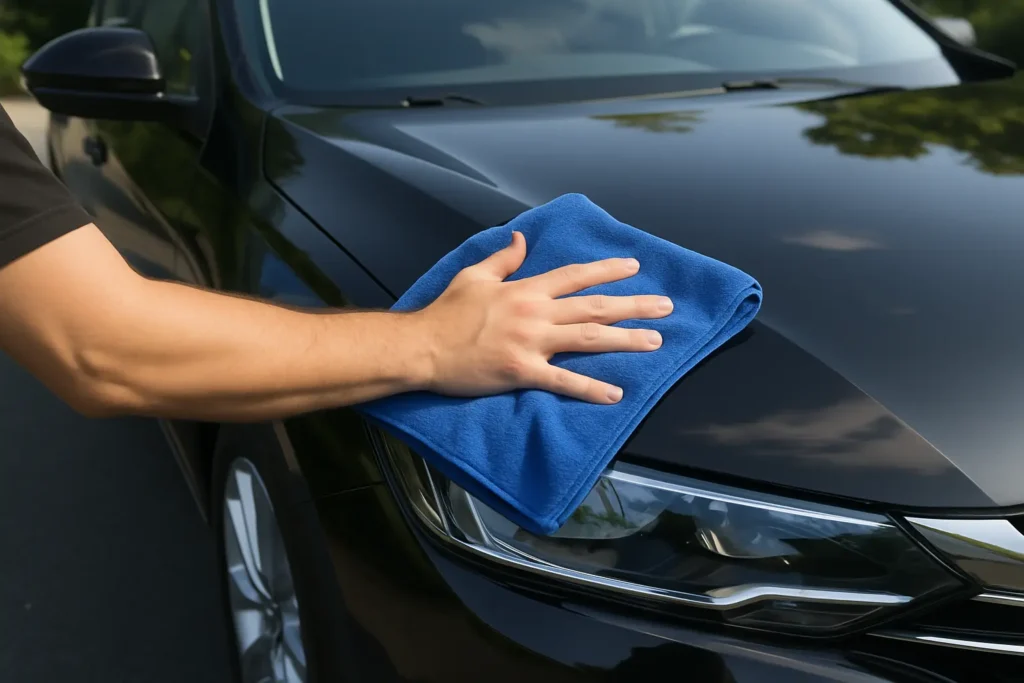
Already struggling with water spots? Do not worry! You can buy special water spot removers that work well. For a natural option, a mix of water and a little vinegar can help dissolve them. For tougher stains, you might need a gentle polish or a professional cleaner. To keep spots away for a long time, consider a ceramic coating. It makes your car surface super slippery, so water forms droplets and slides away, making drying much easier. If your home has hard water, try using filtered water for rinsing or even a waterless car wash. With a little care, your car can stay shiny and spot-free.
Eco-Friendly Car Wash
Today, washing your car is not just about making it look good; it is also about being kind to our planet. An eco-friendly car wash saves water and avoids bad chemicals, all while keeping your car looking its best. Wondering how to do an eco-friendly car wash? It is easier than you might think.
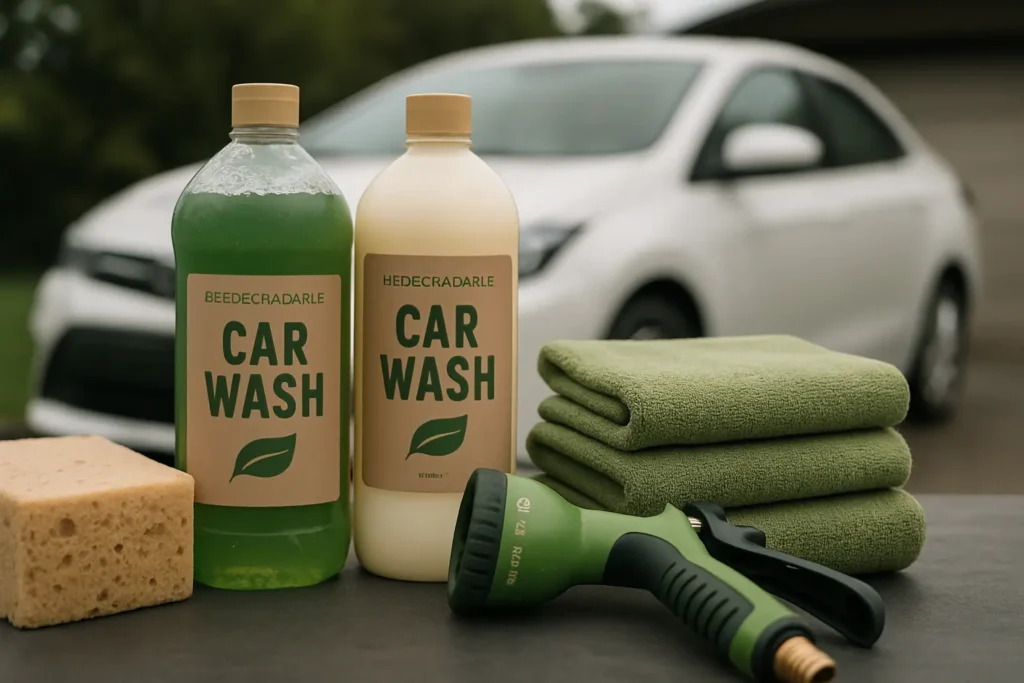
One smart way is to use good quality microfiber towels with special spray nozzles that use less water, or soaps that do not need rinsing. This great combination cleans your car well, uses much less water, and protects your car paint. When picking cleaning stuff, choose soaps that break down naturally and do not have phosphates. These cleaners are tough on dirt but safe for plants, water, and animals.
To go even greener, try waterless car washes. These products use special sprays that lift dirt off your car, so you can clean it without a pressure washer or even a hose! It is a great solution if water availability is limited or if you cannot use a hose. Being eco-friendly does not mean your car would not get clean, it means you are taking care of your car and the world around you.
Cleaning Car Wheels
Want your car wheels to look super clean and shiny? You do not need fancy tools! With the right steps and some basic stuff, you can make them look professional. Here is how to clean your car wheels:
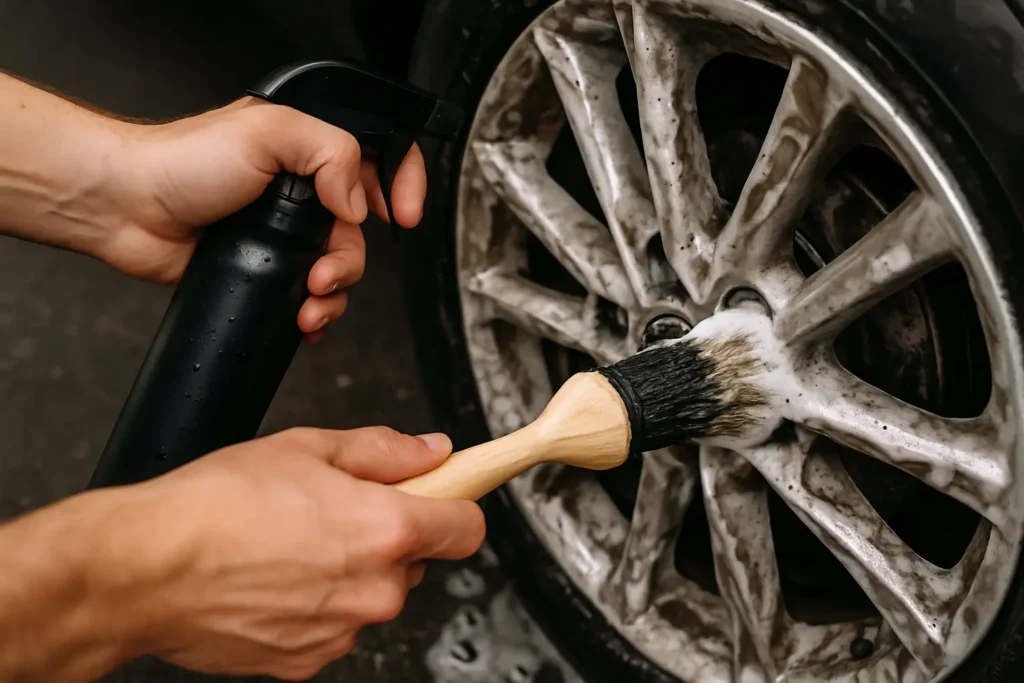
- Rinse First: Spray your wheels all over with water to get rid of loose dirt and dust. Make sure the wheels are cool before you start, especially if you have just driven the car. Hot wheels can make cleaners dry too fast.
- Apply Wheel Cleaner: Spray a special wheel cleaner evenly on the whole wheel. Let it sit for a few minutes, just like the product says. Using the right cleaner is important so you do not hurt the finish of the wheels.
- Scrub Gently: Use a soft brush or a wash mitt to gently scrub the wheels. For those tight spots like around the lug nuts or center caps, a small detail brush works great. If your wheels are really dirty or have stubborn brake dust (that dark, sticky stuff), you might need a special iron remover.
- Rinse Again: After scrubbing, rinse the wheels really well with clean water. Make sure all the cleaner and dirt are gone.
- Dry for Shine: To stop water spots and get a perfect shine, dry the wheels right away with a clean microfiber towel. This last step is key for a truly polished look.
Follow these steps, and your wheels will look brand new, making your whole car look better!
Waterless Car Wash
A waterless car wash is a quick, easy, and eco-friendly way to clean your car, especially when you cannot use a hose or there are water rules. The secret is using special cleaning sprays and soft microfiber towels. If you are wondering how to clean your car without water, it is all about using the right stuff and a good method.
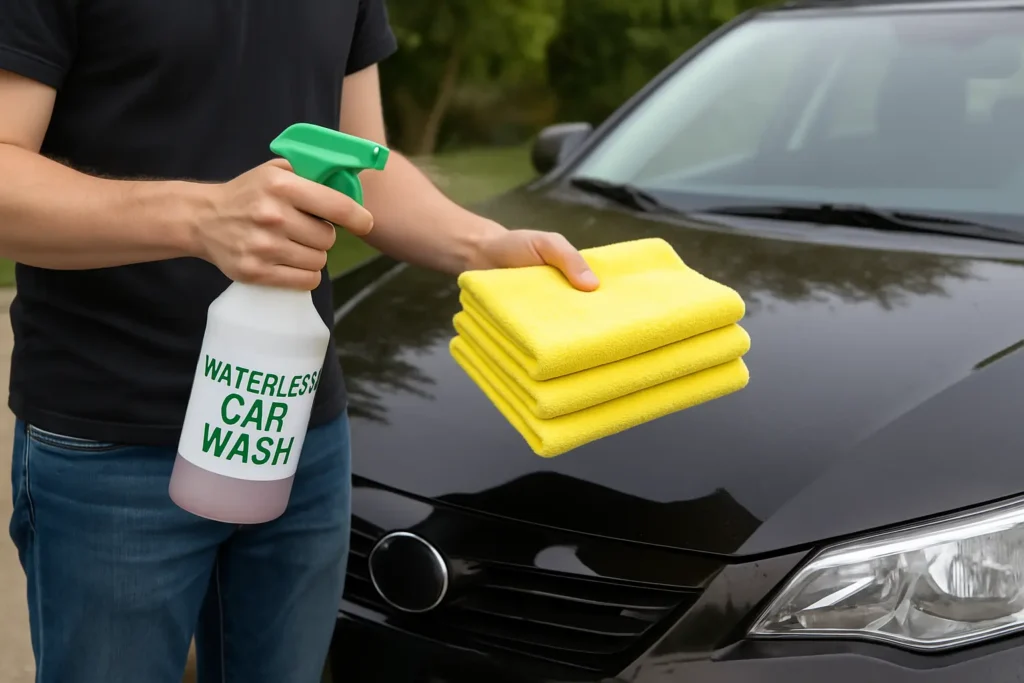
Always pick sprays made for waterless washes. These sprays surround dirt particles, lifting them safely off your car paint. When you spray, use a light touch and always switch to a clean part of your microfiber towel often to avoid scratches. Here is how to do a waterless car wash:
- Get Your Stuff Ready: You will need a waterless car wash spray and lots of clean microfiber towels (at least 10, more for bigger cars). You might also want special cleaners for glass or wheels.
- Spray a Small Area: Work on one small section of your car at a time, like a single door or a part of the hood. Spray the waterless wash solution evenly on that area.
- Wipe Off Dirt: Let the spray sit for a minute or two. This lets the special stuff in the spray lift the dirt. Then, with a clean microfiber towel, gently wipe the spray and dirt away in one direction. Do not wipe in circles, as this can cause swirly marks.
- Buff for Shine: After wiping off the dirt, flip your towel to a clean, dry side, or grab a new towel. Gently rub the area to make it shiny and clean. It is most important to use fresh towels as they get dirty so you do not put dirt back on the paint. Also, use different towels for windows or tires to keep things extra clean.
This way of washing not only saves water but also keeps your car looking great quickly and easily.
Car Wash Wax vs Ceramic Coatings
Making your car look professional is not just about cleaning, it is also about protecting the paint and making it shine. This is where car wax and ceramic coatings come in. Both protect your car from sun, pollution, and small scratches, but they last different amounts of time and are applied differently.
Car Wax has been used for ages. It is usually made from natural stuff like Carnauba wax. it is easy to put on, and creates a protective layer on your car. It gives your car a warm, deep, shiny look and makes water bead up and roll off. But wax does not last as long and needs to be put on more often.
Ceramic Coatings are a newer, more advanced way to protect your car. These products create a super strong, long-lasting shield for your car paint. While they can be a bit more complex to apply at home than wax, they last significantly longer, often for years instead of months. They protect better against chemicals, sun damage, and small scrapes, and make your car super smooth and easy to clean, because water and dirt have a hard time sticking to it.
Tips for Best Results
- Ceramic Waxes: If you want something in between, ceramic waxes are a mix. They are easy to put on like wax but give some of the extra protection of ceramic coatings.
- Polisher Machines: For a really perfect finish, especially when putting on protective layers, a polisher machine can help spread the product evenly and make it work better.
- Check How It is Working: To see if your protection is still good, watch how water forms droplets on your car. If it forms nice, tight droplets, your protection is still strong.
Always use the right tools and follow instructions carefully to avoid damaging your car. For example, harsh polishing can wear down protective layers, so be gentle!
Car Interior Vacuuming
Keeping your car inside clean makes it nicer to drive and helps keep its value. Good news is you do not need special tools! Your home vacuum and a few basic cleaning supplies are usually all you need.
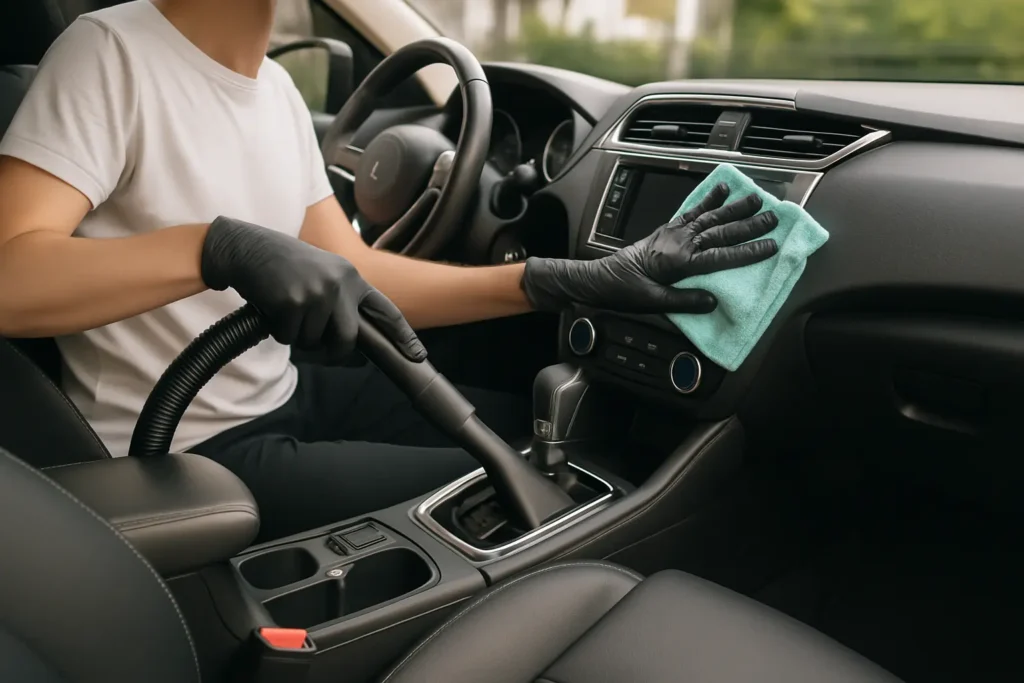
Want to clean your car inside really well without spending a lot?
Here is how:
Step 1: Get Ready
First, clear everything out. Take out floor mats, empty cup holders, and remove any trash or loose items. A clear space makes cleaning much easier.
Step 2: Vacuum Everything
Use your vacuum to clean the carpets, seats, and hard-to-reach spots like under the seats. A narrow tool (crevice tool) is great for tight corners, and a soft brush attachment works well for dashboards and air vents. When vacuuming carpets, press down a bit to pick up hidden dirt.
Step 3: Clean Surfaces
For plastic parts and the dashboard, spray a mild cleaner onto a damp microfiber cloth, then wipe. Do not spray directly on surfaces, especially near electronics. For small details, cotton swabs dipped in cleaner work great. For clear windows, mix water, vinegar, and a tiny bit of rubbing alcohol in a spray bottle. Spray this onto a microfiber cloth, then wipe the windows for no streaks.
If you have salt stains on your carpets, a mix of hot water and vinegar can help. Spray it on, let it sit for a few minutes, then gently scrub with a brush.
Step 4: Care for Seats
Vacuum your seats first. If they are fabric, wipe them with a damp cloth and a mild fabric cleaner. For leather seats, use a special leather soap and conditioner to clean and protect them. Let it dry, then buff for a fresh look.
Step 5: Final Check
Before you are done, look around for any spots you missed. Once it is all clean, put the floor mats back, and enjoy your spotless, fresh car interior. A clean inside makes every drive better!
Conclusion
A do-it-yourself car wash is a super affordable and satisfying way to keep your car looking great without paying a lot of money. By learning how to wash it right, picking the best soaps, cleaning your wheels, stopping water spots, being kind to the environment, and interior detailing, every step you take adds real value to your car.
When you use these simple tips, you not only save cash but also feel good about taking care of your car yourself. So, skip the automatic car wash and put in a little time and effort. You will end up with a clean, well-kept car that shows off your hard work, and the money you save is a nice bonus. Enjoy that shine!
Can I use dish soap to wash my car?
No, it is not a good idea. Dish soap can strip off your car protective wax and might not have the slippery stuff needed to prevent scratches. Always use car wash soaps made for cars.
How do I stop water spots?
Wash your car in the shade or when it is cool. Rinse it really well, and dry it right away with a clean microfiber towel. A ceramic coating can also help water roll off.
Do waterless car washes actually work?
Yes, they do! They are great for light dirt. They use special sprays that lift dirt so you can wipe it away safely with microfiber towels. Plus, they save water.
How often should I wax my car or use a ceramic coating?
It depends on the product. Regular waxes usually last a few months. Ceramic coatings last much longer, often for several years, but they are a bit more complex to apply.
What is the best way to clean my car inside?
First, take out all loose items and vacuum thoroughly. Use a mild cleaner on a damp microfiber cloth for hard surfaces. For seats, vacuum first, then clean with the right product for fabric or leather. Do not forget windows and vents!
